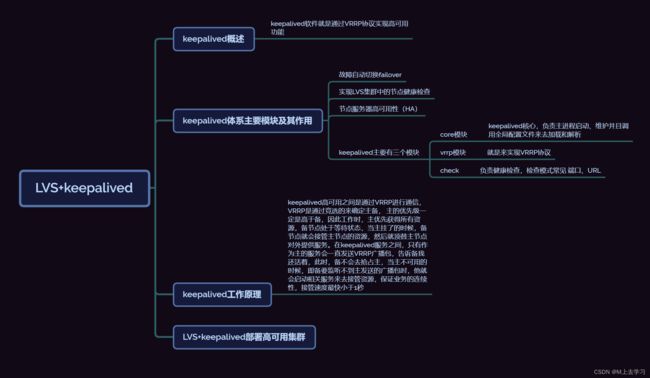LVS-DR+keepalived实现高可用负载群集
VRRP 通信原理:
VRRP就是虚拟路由冗余协议,它的出现就是为了解决静态路由的单点故障。
VRRP是通过一种竞选的一种协议机制,来将路由交给某台VRRP路由。
VRRP用IP多播的方式(多播地址224.0.0.18)来实现高可用的通信,工作时主节点发包,备节点接收包,当备节点接收不到主节点发的数据包时候,就启动接管主节点的资源,备节点可以有多个,通过优先级来进行竞选,但一般keepalived系统运维工作时一对。
VRRP使用加密协议加密数据,但keepalive官方目前还是推荐用明文的方式认证类型和密码。

Keepalived 是一个基于VRRP协议来实现的LVS服务高可用方案,可以解决静态路由出现的单点故障问题。
在一个LVS服务集群中通常有主服务器(MASTER)和备份服务器(BACKUP)两种角色的服务器,但是对外表现为一个虚拟IP,主服务器会发送VRRP通告信息给备份服务器,当备份服务器收不到VRRP消息的时候,即主服务器异常的时候,备份服务器就会接管虚拟IP,继续提供服务,从而保证了高可用性。
Keepalived体系主要模块及其作用:
keepalived体系架构中主要有三个模块,分别是core、check和vrrp。
●core模块:为keepalived的核心,负责主进程的启动、维护及全局配置文件的加载和解析。
●vrrp模块:是来实现VRRP协议的。
●check模块:负责健康检查,常见的方式有端口检查及URL检查。
以下实验使用LVS-DR+keepalived的抢占模式实现高可用负载群集:
Web 服务器1:20.0.0.101(VIP 20.0.0.10)
Web 服务器2:20.0.0.102(VIP 20.0.0.10)
NFS 共享存储器:20.0.0.103
LVS+keepalived 主负载调度器:20.0.0.104(VIP 20.0.0.10)
LVS+keepalived 备负载调度器:20.0.0.105(VIP 20.0.0.10)
网关/路由器:20.0.0.2
客户端:192.168.116.50
一、配置NFS共享存储
systemctl stop firewalld.service
systemctl disable firewalld.service
setenforce 0
yum -y install nfs-utils rpcbind
mkdir /opt/nfs/server1 /opt/nfs/server2
chmod -R 777 /opt/nfs
vim /etc/exports
/opt/nfs 20.0.0.0/24(rw,sync)
/opt/nfs/server1 20.0.0.0/24(rw,sync)
/opt/nfs/server2 20.0.0.0/24(rw,sync)
systemctl restart rpcbind.service
systemctl restart nfs.service
检查发布的共享策略
showmount -e
在共享目录中添加web测试页面:
mkdir /opt/nfs/server1 server2
echo this is web-01 ! >>/opt/nfs/server1/index.html
echo this is web-02 ! >>/opt/nfs/server2/index.html
检查一下是否写入成功:
cat /opt/nfs/server1/index.htmlcat
cat /opt/nfs/server2/index.html
二.配置节点web服务(20.0.0.101 20.0.0.102两台的配置相同)
【安装 Nginx 服务】
1、安装依赖包
yum -y install pcre-devel zlib-devel gcc gcc-c++ make
2、创建运行用户
useradd -M -s /sbin/nologin nginx
3、编译安装
cd /opt
tar zxvf nginx-1.22.0.tar.gz -C /opt/
cd nginx-1.22.0/
./configure \
--prefix=/usr/local/nginx \
--user=nginx \
--group=nginx \
--with-http_stub_status_module
make -j 4 && make install
4、优化路径
ln -s /usr/local/nginx/sbin/nginx /usr/local/sbin/
5、添加 Nginx 系统服务
vim /lib/systemd/system/nginx.service
[Unit]
Description=nginx
After=network.target
[Service]
Type=forking
PIDFile=/usr/local/nginx/logs/nginx.pid
ExecStart=/usr/local/nginx/sbin/nginx
ExecReload=/bin/kill -s HUP $MAINPID
ExecStop=/bin/kill -s QUIT $MAINPID
PrivateTmp=true
[Install]
WantedBy=multi-user.target
[Unit]:这个部分定义了服务单元的元数据。
Description: 描述该服务单元的信息,描述为"nginx"。
After: 定义服务单元所依赖的其他单元,这里表示服务需要在网络加载完成之后启动。
[Service]:这个部分定义了服务的运行配置。
Type: 指定服务的类型,这里是forking,表示服务是一个后台进程(通常是fork出子进程)。
PIDFile: 指定保存主进程ID的文件路径,Nginx将会把主进程ID写入这个文件,以便Systemd可以追踪和管理进程。
ExecStart: 指定启动服务的命令。这里是启动Nginx的命令/usr/local/nginx/sbin/nginx。
ExecReload: 指定重新加载配置的命令。当执行此命令时,Systemd将发送HUP信号给主进程,Nginx将重新加载配置文件。
ExecStop: 指定停止服务的命令。当执行此命令时,Systemd将发送QUIT信号给主进程,Nginx将优雅地停止服务。
PrivateTmp: 将此项设置为true,表示为服务提供独立的临时目录。
[Install]:这个部分定义了服务的安装配置。
WantedBy: 指定服务所属的目标(target),这里是multi-user.target,表示服务在多用户模式下启动。
chmod 777 /lib/systemd/system/nginx.service
systemctl start nginx.service
systemctl enable nginx.service
查看nginx服务是否启动:
netstat -antp | grep 80
将网站根目录挂载到各自的共享目录
首先打开nfs服务:
systemctl restart rpcbind.service
systemctl restart nfs.service
mount 20.0.0.103:/opt/nfs/server1 /usr/local/nginx/html/
mount 20.0.0.103:/opt/nfs/server2 /usr/local/nginx/html/
在web01 -02上查看是否共享成功
cat /usr/local/nginx/html/index.html
cat /usr/local/nginx/html/index.html
设置回环网卡,虚拟ip(web-01 web-02都要设置)
cp /etc/sysconfig/network-scripts/ifcfg-lo /etc/sysconfig/network-scripts/ifcfg-lo:0
vim /etc/sysconfig/network-scripts/ifcfg-lo:0
DEVICE=lo:0
IPADDR=20.0.0.10
NETMASK=255.255.255.255
ONBOOT=yes
~
ifup lo:0
配置回环网卡完成后
ifconfig 查看一下是否配置成功
添加静态路由(将数据包封锁在回环网卡中)
#临时配置
route add -host 20.0.0.10 dev lo:0
#永久配置
vim /etc/rc.local
/sbin/route add -host 20.0.0.10 dev lo:0
chmod +x /etc/rc.d/rc.local
调整内核的ARP响应参数(阻止更新VIP的MAC地址,防止发生冲突)
vim /etc/sysctl.conf
#添加
net.ipv4.conf.lo.arp_ignore = 1
net.ipv4.conf.lo.arp_announce = 2
net.ipv4.conf.all.arp_ignore = 1
net.ipv4.conf.all.arp_announce = 2
#加载配置文件并查看
sysctl -p
三、配置主备LVS+keepalived负载调度器(keepalived-01 ;keepalived-02)
关闭防火墙下载keepalived和ipvsadm,并修改内核参数
systemctl stop firewalld.service 。
systemctl disable firewalld.service
setenforce 0
modprobe ip_vs
yum -y install ipvsadm keepalived
vim /etc/sysctl.conf
net.ipv4.ip_forward = 0
net.ipv4.conf.all.send_redirects = 0
net.ipv4.conf.default.send_redirects = 0
net.ipv4.conf.ens33.send_redirects = 0
sysctl -p
修改主负载器配置文件:
cd /etc/keepalived/
cp keepalived.conf keepalived.conf.bak #改配置文件前先备份
vim keepalived.conf
global_defs {
notification_email {
acassen@firewall.loc
failover@firewall.loc
sysadmin@firewall.loc
}
notification_email_from Alexandre.Cassen@firewall.loc
smtp_server 127.0.0.1
smtp_connect_timeout 30
router_id LVS_01
#vrrp_skip_check_adv_addr
#vrrp_strict
#vrrp_garp_interval 0
#vrrp_gna_interval 0
}
vrrp_instance VI_1 {
state MASTER
interface ens33
virtual_router_id 51
priority 100
advert_int 1
authentication {
auth_type PASS
auth_pass abc123
}
virtual_ipaddress {
20.0.0.10
}
}
virtual_server 20.0.0.10 80 {
delay_loop 6
lb_algo rr
lb_kind DR
persistence_timeout 10
protocol TCP
real_server 20.0.0.101 80 {
weight 1
TCP_CHECK {
connect_port 80
connect_timeout 3
nb_get_retry 3
delay_before_retry 3
}
}
real_server 20.0.0.102 80 {
weight 1
TCP_CHECK {
connect_port 80
connect_timeout 3
nb_get_retry 3
delay_before_retry 3
}
}
}
修改备负载器配置文件(与主配置一致,只需修改以下部分) :
global_defs {
notification_email {
acassen@firewall.loc
failover@firewall.loc
sysadmin@firewall.loc
}
notification_email_from Alexandre.Cassen@firewall.loc
smtp_server 127.0.0.1
smtp_connect_timeout 30
router_id LVS_02
#vrrp_skip_check_adv_addr
#vrrp_strict
#vrrp_garp_interval 0
#vrrp_gna_interval 0
}
vrrp_instance VI_1 {
state BACKUP
interface ens33
virtual_router_id 51
priority 90
advert_int 1
authentication {
auth_type PASS
auth_pass abc123
}
virtual_ipaddress {
20.0.0.10
}
}
virtual_server 20.0.0.10 80 {
delay_loop 6
lb_algo rr
lb_kind DR
persistence_timeout 10
protocol TCP
real_server 20.0.0.101 80 {
weight 1
TCP_CHECK {
connect_port 80
connect_timeout 3
nb_get_retry 3
delay_before_retry 3
}
}
real_server 20.0.0.102 80 {
weight 1
TCP_CHECK {
connect_port 80
connect_timeout 3
nb_get_retry 3
delay_before_retry 3
}
}
}
启动keepalived再启动ipvsadm(ipvsadm会自动加载keepslived中的配置:
systemctl restart keepalived.service
ipvsadm-save > /etc/sysconfig/ipvsadm
#启动ipvsadm (分别添加主备负载均衡器VIP 的分发策略)
systemctl restart ipvsadm.service
ipvsadm -C ##清空规则
ipvsadm -A -t 20.0.0.10:80 -s rr
ipvsadm -a -t 20.0.0.10:80 -r 20.0.0.101:80 -g
ipvsadm -a -t 20.0.0.10:80 -r 20.0.0.102:80 -g
查看主负载和副负载均衡器:
ipvsadm -ln
访问:20.0.0.10
可以将主负载器服务停止或关机(模拟宕机),继续访问 20.0.0.10查看主备切换是否正常
脑裂现象的解释和解决办法:
1.解释
在抢占模式中,MASTER需要定时发送报文通告BACKUP自己仍在运作,但是当MASTER还在运作,但其中的线路或交换机等出现故障导致BACKUP不能收到通告时,会认为MASTER已经失效,此时BACKUP抢占VIP会导致VIP同时存在,这就是脑裂现象。
2.解决方法
1.主备服务器之间使用双链路通信;
2. 通过脚本来实时监控主备的网络状态,然后再根据脚本逻辑采取措施(关掉主服务器的keepalived服务器);
